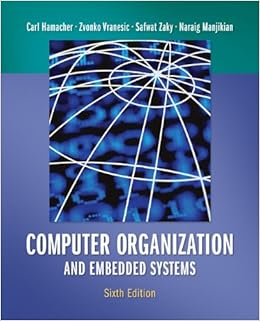
Free Downloads Computer Organization And Embedded Systems

The sixth edition of this book covers the key topics in computer organization and embedded systems. It presents hardware design principles and shows how hardware design is influenced by the requirements of software. The book carefully explains the main principles supported by examples drawn from commercially available processors. The book is suitable for undergraduate electrical and computer engineering majors and computer science specialists. It is intended for a first course in computer organization and embedded systems.

Hardcover: 736 pages
Publisher: McGraw-Hill Education; 6 edition (January 27, 2011)
Language: English
ISBN-10: 0073380652
ISBN-13: 978-0073380650
Product Dimensions: 7.5 x 1.3 x 9.4 inches
Shipping Weight: 2.7 pounds (View shipping rates and policies)
Average Customer Review: 4.5 out of 5 stars See all reviews (17 customer reviews)
Best Sellers Rank: #601,372 in Books (See Top 100 in Books) #69 in Books > Computers & Technology > Hardware & DIY > Microprocessors & System Design > Embedded Systems #300 in Books > Computers & Technology > Hardware & DIY > Design & Architecture #3379 in Books > Computers & Technology > Computer Science

An excellent book, very complete and very detailed. Mostly well written and clear. It explains MC68K and Power PC archtiectures. It is very indepth when it comes to microprogramming. A good overview of Assembly concepts. You will learn about microprocessors inside out, including Intel Pentium family with superscalar features and the importance of pipelining and compiler optimization. A great reference for profesionals, a superb guide for undergrads.
This was the assigned text for my junior year computer engineering course on computer organization. I loved it. The explanations are clear, progress logically, and are clearly presented. I find myself picking it up from time to time, both to read the more advanced chapters out of personal interest and to look up details needed in more advanced coursework.
I have been teaching a course on computer organisation and architecture for the past 8 years. I have used different textbooks during this period. This is the best one. It is very complete and detailed. It is way better than most of the computer organisation/architecture textbooks in the market. In particular, it is better than Stallings' and Tanenbaum's books.It starts with architecture where it devotes 3 chapters about this topic. The chapters are great although I still prefer if they have used a specific assembly language (like MIPS) instead of something virtual.The next 4 chapters cover processor, I/O and memory. The explanation for the processor is great. The memory is also great but I did not like the I/O chapter. I feel it was not well written specially when it covers the I/O standards where the explanation is confusing.In a nutshell, I strongly recommend this textbook. However, in many cases you need to be patient and read the paragraphs few times to digest the material.===EDITAfter carefully reading Tanenbaum's textbook, I have to revise the above review. I think Tanenbaum's textbook is also great. But I have to say that you need to read Chap. 4 (The Microarchitecture Level) several times to digest it. But if you understood it then you would fully understand how processors work. I have switched to Tanenbaum's textbook.
I know I purchased this book to learn, but does it have to be so dry and humorless? I end up just browsing around on the interwebs when I have trouble in this class instead of reading this book. That being said, I does contain a lot of good information, despite being rather outdated.
A clearly written book, which employs a simple language. Another beauty of the book is that all loose ends are tied up. As sentences unfold one will realize why a particular phrase was used earlier and so on. That makes a big difference for an engineering text book.It is the best book that I know for fundamentals. Hence, it will be useful for years to come.Must have for all embedded systems people.
The authors introduce every concepts in detail, and the hardware circuits are clearly illustrated.
Helped me in my undergrad (older version). Helped me when I gave subject GRE recently. Covered Pipelining superscalar, out-of-order execution processors, caching and secondary storage, combinational and sequential ckt review etc real well. No computer architecture book covered them all so clearly, and in one book.
Absolutely fascinating book. Explains how you can move from a single transistor up to a real computer.
Computer Organization and Embedded Systems HACKING: Beginner's Crash Course - Essential Guide to Practical: Computer Hacking, Hacking for Beginners, & Penetration Testing (Computer Systems, Computer Programming, Computer Science Book 1) Computer Organization and Design, Fourth Edition: The Hardware/Software Interface (The Morgan Kaufmann Series in Computer Architecture and Design) Computer Organization and Design, Third Edition: The Hardware/Software Interface, Third Edition (The Morgan Kaufmann Series in Computer Architecture and Design) Computer Organization and Design: The Hardware Software Interface: ARM Edition (The Morgan Kaufmann Series in Computer Architecture and Design) Introduction to Computer Organization and Data Structures, Pdp-11 Edition (McGraw-Hill computer science series) DSP Software Development Techniques for Embedded and Real-Time Systems (Embedded Technology) Embedded Systems Architecture: A Comprehensive Guide for Engineers and Programmers (Embedded Technology) Applied Control Theory for Embedded Systems (Embedded Technology) Design Patterns for Embedded Systems in C: An Embedded Software Engineering Toolkit Analog Interfacing to Embedded Microprocessor Systems, Second Edition (Embedded Technology Series) Real-Time UML Workshop for Embedded Systems, Second Edition (Embedded Technology) Computer Systems Organization and Architecture Computer Systems Organization & Architecture Linux for Embedded and Real-time Applications, Third Edition (Embedded Technology) Linux for Embedded and Real-time Applications (Embedded Technology) Linux for Embedded and Real-time Applications, Second Edition (Embedded Technology) TCP/IP Embedded Internet Applications (Embedded Technology) Embedded Systems Security: Practical Methods for Safe and Secure Software and Systems Development Introduction to Embedded Systems: Using ANSI C and the Arduino Development Environment (Synthesis Lectures on Digital Circuits and Systems)



